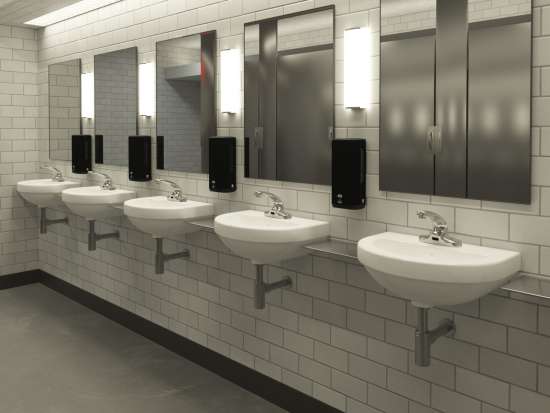Everything you wanted to know about commercial sensor faucets but were afraid to ask
Articles

Sensor faucets have become nearly ubiquitous in public facilities. They're in airport bathrooms, stadium bathrooms and maybe even the bathroom down the hall at your office.
That widespread presence can make them feel ordinary, almost pedestrian. And if you've still got questions, well, woe be to you.
But even though sensor faucets have ridden a COVID-fueled
wave of popularity for more than two years, many people still have questions about
their operation, how best to choose fixtures for various environments and what
to expect in the long run.
Rest easy. We've got answers to the most asked questions.
1. How do sensor faucets work?
For almost all sensor-operated faucets, an infrared beam is built into the faucet's base or spout. When the beam is interrupted, typically by hands being placed beneath the spout, water flow is activated.
Water stops flowing when either the beam is restored, i.e. when hands are moved away from the spout, or when a preset timeout period has been reached.
Sensor faucets are typically powered by one of three options: battery, plugging into the building's electricity source or hydrogenator, which harnesses the flow of water to generate power. (See question 6 below to decide which is right for your facility.)
Depending on the faucet selected, sensor faucets may or may not allow users to adjust the temperature. Some models, like the EC-3142 from T&S Brass, have an integrated temperature handle. Others may incorporate a mixing valve in hidden or inaccessible areas, making it so that temperature settings are established or modified only by installers or facility maintenance staff.
2. What are the benefits?
The most recognizable and sought-after benefit of sensor faucets is hygiene.
The faucets of frequently used faucets can harbor up to 229,000 germs per square inch. These pathogens can potentially re-contaminate clean hands when the user touches the faucet to turn the water off.
By removing the handles used to operate manual faucets, sensor faucets eliminate the common touchpoint and boost hygiene.
Switching to sensor faucets not only promotes cleanliness but also improves perception among users. A recent survey of Americans' perception of public restrooms revealed 84% of Americans believe it's important for public restrooms to have hands-free fixtures, and 64% indicated they were more likely to return to a business that offered touchless capabilities in its restrooms.
A further, sometimes unknown, benefit of sensor faucets is water conservation - and the reduced expense that accompanies it.
Sensor faucets reduce water consumption by up to one gallon per hand wash by running water only when in use. Associated energy and sewer costs to heat and dispose of the water - on average 9 and 1.5 times higher than the water itself, respectively - increase the financial savings of conserving water.
Thanks to an automatic time-out feature, sensor faucets also can't be left to run untended - either maliciously or by accident - preventing more potential water waste or overflow damage.
3. What are the drawbacks?
Quality sensor faucets have a higher initial cost than comparable manual faucets. But most facilities believe the investment to be a valuable one.
Incorrect installation or programming can cause sensor faucets to not activate correctly, leading to user frustration. And irregular or inconsistent maintenance to replace batteries can also cause the faucet to not function.
These issues are easily rectified by following manufacturer installation instructions and adhering to a regular maintenance schedule (or circumventing the need by choosing a different power source for your faucets).
4. Are they reliable?
Yes. Well-built, commercial-grade sensor faucets like those from T&S are designed to last for years. They require little maintenance - typically only battery changes and periodic cleaning of the debris filter.
5. Are they worth it?
The answer depends on factors like your water usage and costs and the value you place on public perception, but in short, yes.
Explore more about the common objections to sensor faucets and the pros and cons to weigh in your decision making here.
6. How do I decide which sensor faucet to choose?
There are a few key components to consider when selecting a sensor faucet. The first is whether to choose below-deck or above-deck electronics.
Both
setups function identically for customers. The main differences are aesthetics
and maintenance accessibility. Below-deck options hide the electronics and
provide a more compact presence; above-deck versions allow easier access to
batteries for replacement.
Power
source is another option to consider. Battery-operated faucets are the most
common but require regular attention to battery changes. Installing a hydrogenator
or selecting an easywire or hardwire option eliminates the batteries, making
your faucets even easier to operate and maintain.
Think
also about planning for the future as much as possible. Anticipating potential
changes will make future updates or replacements less likely - or at least less
frequent.
Are the fixtures ADA-compliant? Do they meet (or exceed) current sustainability goals? Have you selected faucets that allow for retrofitting of aerators or other devices that may become available in the future?
And,
of course, always choose a high-quality product that's designed to last in
commercial environments.
T&S
can help you select the perfect solution for your needs with this step-by-step guide to selecting the perfect
electronic sensor faucet, including information on power sources, outlet
devices, body style, mixing valves and more.







